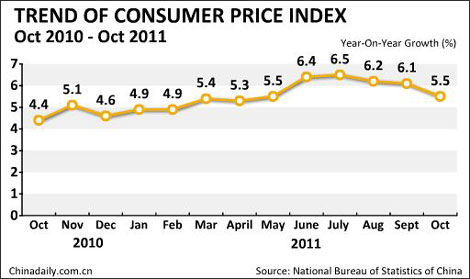China's consumer price index (CPI), the main gauge of inflation, rose 5.5 percent year-on-year in October, weakening from September's 6.1 percent, the National Bureau of Statistics (NBS) said on Wednesday.
The October CPI growth marked the slowest surge since May this year, softening from 6.1 percent in September, 6.2 percent in August, 6.5 percent in July and 6.4 percent in June.
"The October CPI data showed that the government's price control efforts have started to pay off," said Zhang Liqun, a macroeconomic researcher with the Development Research Center of the State Council, or China's Cabinet.
Zhang said the slowing price increases will create favorable conditions for the country to fine-tune its monetary tightening policies, although inflationary pressure will remain due to a large outstanding broad money supply (M2).
By the end of September, the gross M2 still stood at 78.74 trillion yuan ($12.4 trillion), about 1.8 times larger than China's gross domestic product (GDP). In 2008, it was only 1.54 times larger than the GDP, Zhang said.
"The size of the money supply remains huge and policymakers should be careful about (loosening) the monetary policy and not ignore its potential for boosting prices," he said. "It is a critical moment for the country's macroeconomic control policies and we can't be too careless in loosening the policies."
Prior to the NBS announcement, many economists expected the October CPI to rise by 5.4 percent year-on-year.
On a monthly basis, the cost of living in October was still 0.1 percent higher than September, although it was still lower than the 0.5 percent month-on-month growth in September, according to the NBS.
Food prices, which account for nearly one-third of the basket of goods used to calculate the CPI, moved up 11.9 percent in October from a year earlier but dipped 0.2 percent month-on-month, according to NBS data.
China's CPI hit a 37-month high of 6.5 percent in July this year, far above the government's full-year target of 4 percent.
China's PPI up 5.0% in October
China's Producer Price Index (PPI), a main gauge of inflation at the wholesale level, rose 5 percent year-on-year in October, the National Bureau of Statistics (NBS) said Wednesday.
The reading eased from a growth of 6.5 percent in September.
The decline is bigger, as the index for October was previously estimated at between 5.7 percent and 6 percent, according to the Xinhua macro-economic data survey.
On a month-on-month basis, October's reading fell 0.7 percent from that recorded in September, the NBS said in a statement on its website.
An easing PPI shows that the government's cooling measures have begun to take effect, according to Chen Kexin, an analyst with the Distribution Productivity Promotion Center of China Commerce.
He also said that a cooling real economy will sap demand for raw materials and thus drag down prices.
The producer prices of production materials rose 5.2 percent in October year-on-year, and decreased 0.8 percent from a month earlier.
The producer price level for non-ferrous metal slumped 4.9 percent from a month ago, while that for fuel edged down 0.3 percent.
However, Chen said there is still uncertainty regarding whether the PPI will continue to fall.
As fears of a double-dip global recession are still prevailing, many countries are implementing stimulus plans to boost growth, which leaves room for price hikes, he said.


















